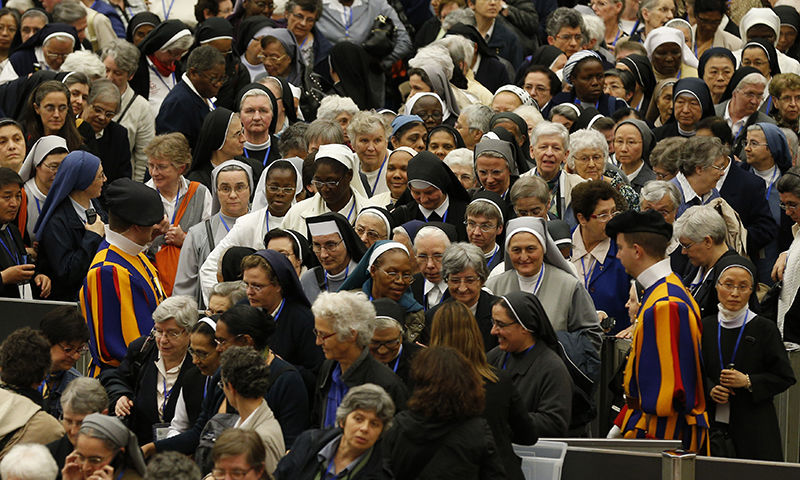One of the more striking Catholic pilgrimages in recent memory wrapped up in early July with a small Mass at a side altar in St. Peter’s Basilica.
A group of eight people, seven women and one man, had trekked more than 600 miles from St. Gallen in Switzerland to Rome, carrying nothing more than backpacks and walking sticks, and concluded their journey by walking through the Holy Door of St. Peter’s and then taking part in a private liturgy.
In principle, there’s nothing unusual about the experience itself, as covering long distances on foot always has been part of the pilgrimage tradition.
What sets this one apart is the motive: The eight pilgrims covered that ground carrying signs that read “For a Church with women,” saying they wanted to make a point about the need for Catholicism to do a better job of listening to women’s voices.
“In the future, we don’t want the men of the Church to undertake any more reflections without women on issues that regard their position, role and function, and we don’t want them to make decisions without women on anything that regards the life of the Church,” said Hildegard Aepli, who initiated the project.
The group, which set out on May 2 and arrived in Rome on June 29, had no intention of defying Catholic orthodoxy — they were not advocating women priests, for instance.
“We want to move towards equal rights with the men of the Church, not against them,” Aepli said.
The group enjoyed the support of Bishop Markus Büchel of St. Gallen, who said he “walked spiritually” with them, and who traveled to Rome to celebrate Mass for them on July 2.
The eight pilgrims had hoped for a meeting with Pope Francis, but settled for delivering a letter to the pontiff.
“We suffer because many women feel like strangers in our Church,” the letter said, “not taken seriously or feeling unwelcome, because they are too little involved in responsible bodies and in decision-making processes.”
The letter says the group “has not developed a concrete list of demands,” wanting only to open a dialogue, and asks Francis to help ensure that women “have a say” both in the Vatican and in local churches around the world.
Though a small undertaking, the pilgrimage illustrates a much bigger challenge for the Catholic Church, to wit: It has a “woman problem.”
To be clear, we’re talking here at the level of perception and the way some people experience the Church, without passing judgment on the rights and wrongs of those perceptions.
For sure, there are scores of satisfied, emancipated Catholic women who do not see themselves as second-class citizens, and who regard much of the criticism of the Church for being “anti-woman” as overblown, often more an index of opposition to its teaching on sexual morality than any real gender inequality.
However, other responsible and faithful Catholics, both men and women, don’t feel that way. They see a Church whose leadership is dominated by men, and in which the decisions that matter almost always are made by men.
Pope Francis himself is one of those people. He’s said repeatedly he wants greater roles for women, including a greater presence in the arenas where decisions are made, and also that Catholicism needs a deeper theology of women.
At the same time, he’s taken women priests off the table, saying St. John Paul II closed that door and it will remain closed. He’s also said that in his view, more important than the functions women play in the Church is finding new ways to hear their voices.
Of course, those two points aren’t entirely unrelated, since women with visible and consequential functions generally stand a better chance of being heard.
On that front, there are several steps Francis could take to boost the roles played by women that don’t involve ordination. Without any pretense of being comprehensive, here are a few concrete examples.
› Appoint women to high-profile Vatican positions that don’t depend on the sacrament of Holy Orders, such as serving as the papal spokesperson, the president of the Vatican bank, or a member of the Council for the Economy.
›Take up the suggestion of Lucetta Scaraffia, who edits a special section on women for the Vatican newspaper L’Osservatore Romano, and create a council of lay advisers from around the world to complement the pope’s “C-9” council of cardinal advisers. Both could serve as kitchen cabinets for Francis, and the lay body could include women as well as men.
› Make it clear that it’s OK for bishops’ conferences to appoint women as their general secretary. The South African bishops did just that in 2012, but when the Americans were considering it in 2000, they were warned off by Rome.
Politically speaking, there’s a hardened school of thought in some corners of the Church that will never be satisfied with anything less than ordaining women to both the priesthood and the episcopacy, and which would regard steps such as those listed above as window-dressing.
Most Catholics, however, are realistic enough to grasp that, whatever their private opinion on ordination may be, it’s not going to happen, and therefore real progress has to come somewhere else.
The good news for people such as the St. Gallen pilgrims, who say they come to the conversation without a predetermined agenda, is that there’s a surprisingly wide range of possible steps in the here-and-now that don’t impinge on Catholic teaching or tradition.
“Men and women of our Church are waiting and will thank you” for taking some of those steps, the pilgrims wrote in their letter to Francis, “and the Church can only win if women are better able to bring their charisms and gifts.”
Many Catholics would probably say, it’s hard to argue with that.
This article orginally appeared at cruxnow.com.

